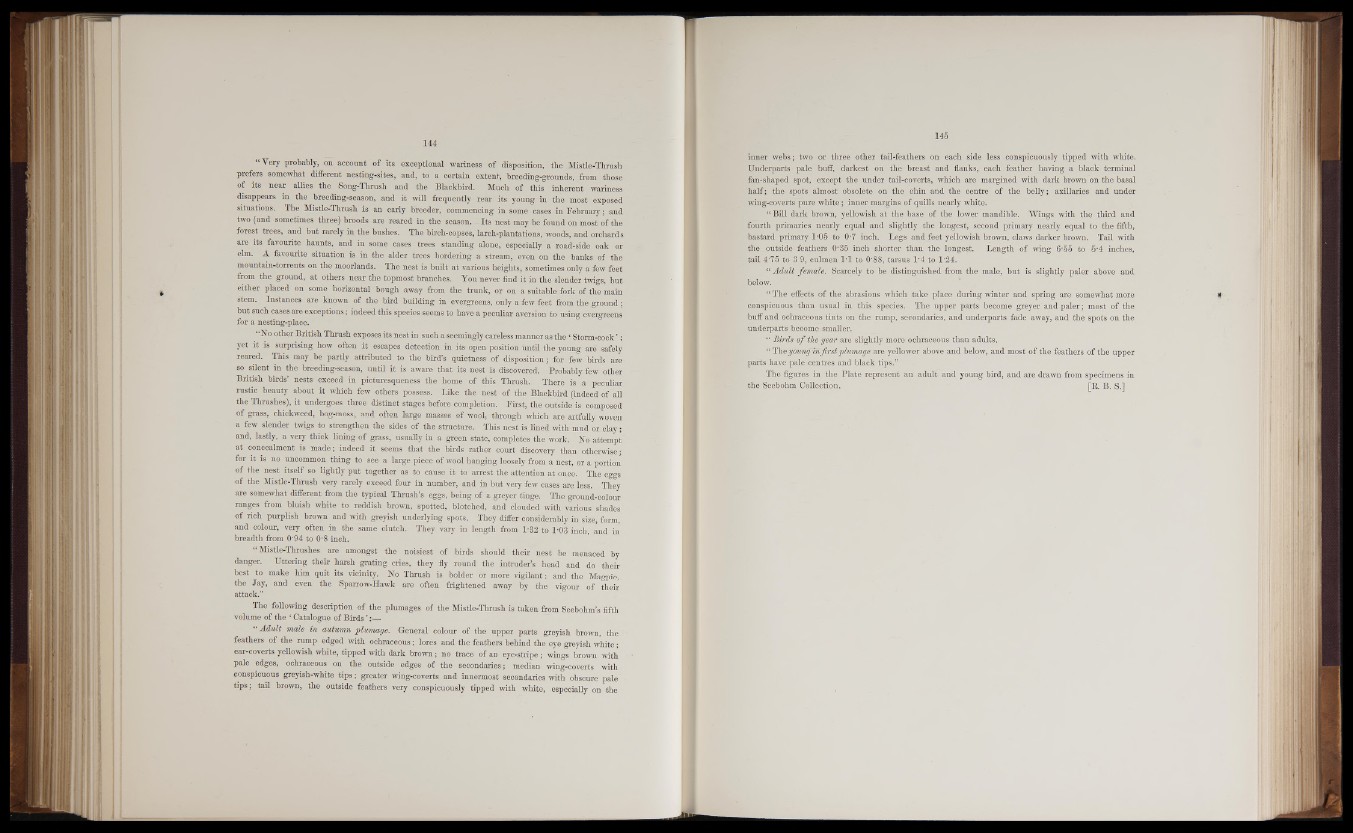
“ Very probably, on account of its exceptional wariness of disposition, the Mistle-Thrush
prefers somewhat different nesting-sites, and, to a certain extent, breeding-grounds, from those
of its near allies the Song-Thrush and the Blackbird. Much of this inherent wariness
disappears in the breeding-season, and it will frequently rear its young in the most exposed
situations. The Mistle-Thrush is an early breeder, commencing in some cases in February ; and
two (and sometimes three) broods are reared in the season. Its nest may be found on most of the
forest trees, and but rarely in the bushes. The birch-copses, larch-plantations, woods, and orchards
are its favourite haunts, and in some cases trees standing alone, especially a road-side oak or
elm. A favourite situation is in the alder trees bordering a stream, even on the banks of the
mountain-torrents on the moorlands. The nest is built at various heights, sometimes only a few feet
from the ground, at others near the topmost branches. You never find it in the slender twigs, but
* either P^ced on some horizontal bough away from the trunk, or on a suitable fork of the main
stem. Instances are known of the bird building in evergreens, only a few feet from the ground •
but such cases are exceptions; indeed this species seems to have a peculiar aversion to using evergreens
for a nesting-place.
“No other British Thrush exposes its nest in such a seemingly careless manner as the ‘ Storm-cock * ;
yet it is surprising how often it escapes detection in its open position until the young are safely
reared. This may be partly attributed to the bird’s quietness of disposition 1 for few birds are-
so silent in the breeding-season, until it is aware that its nest is discovered. Probably few other
British birds’ nests exceed in picturesqueness the-home of this Thrush. There is a peculiar
rustic beauty about it which few others possess.' Like the nest of the Blackbird (indeed of all
the Thrushes), it undergoes three distinct stages before completion. First, the outside is composed
o f grass, chickweed, bog-moss, and often large masses of wool, through which are artfully woven
a few slender twigs to strengthen the sides of the structure. This nest is lined with mud or d a y ;
and, lastly, a very thick lining of grass, usually in a green state, completes the work. No attempt
at concealment is made; indeed it seems that the birds rather court discovery than otherwise;
for it is no uncommon thing to see a large piece of wool hanging loosely from a nest, or a portion
o f the nest itself so lightly put together as to cause it to arrest the attention at once. The eggs
of the Mistle-Thrush very rarely exceed four in number, and in but very few cases are less. They
are somewhat different from the typical Thrush’s eggs, being of a greyer tinge. The ground-colour
ranges from bluish white to reddish brown, spotted, blotched, and clouded with various shades
o f rich purplish brown and with greyish underlying spots. They differ considerably in size, form,
and colour, very often in the same clutch. They vary in length from 1*32 to 1*03 inch, and in
breadth from 0‘94 to 0-8 inch.
“ Mistle-Thrushes are amongst the noisiest of birds should their nest be menaced by
danger. Uttering their harsh grating cries, they fly round the intruder’s head and do their
best to make him quit its vicinity. No Thrush is bolder or more vigilant; and the Magpie,
the Jay, and even the Sparrow-Hawk are often frightened away by the vigour of their
attack.”
The following description of the plumages of the Mistle-Thrush is taken from Seebohm’s fifth
volume of the ‘ Catalogue of Birds ’:—
“ Adult male in autumn plumage. General colour of the upper parts greyish brown, the
feathers of the rump edged with ochraceous; lores and the feathers behind the eye greyish white;
ear-coverts yellowish white, tipped with dark brown; no trace of an eye-stripe; wings brown with
pale edges, ochraceous on the outside edges of the secondaries; median wing-coverts with
conspicuous greyish-white tip s; greater wing-coverts and innermost secondaries with obscure pale
tips; tail brown, the outside feathers very conspicuously tipped with white, especially on the
inner webs; two or three other tail-feathers on each side less conspicuously tipped with white.
Underparts pale buff, darkest on the breast and flanks, each feather having a black terminal
fan-shaped spot, except the under tail-coverts, which are margined with dark brown on the basal
half; the spots almost obsolete on the chin and the centre of the belly; axillaries and under
wing-coverts pure white; inner margins of quills nearly white.
“ Bill dark brown, yellowish at the base of the lower mandible. Wings with the third and
fourth primaries nearly equal and slightly the longest, second primary nearly equal to the fifth,
bastard primary 1*05 to 0-7 inch. Legs and feet yellowish brown, claws darker brown. Tail with
the outside feathers 0*35 inch shorter than the longest. Length of wing 6-55 to 5*4 inches,
tail 4*75 to 3 9, culmen 1*1 to 0*88, tarsus 1*4 to 1*24.
“ Adult female. Scarcely to be distinguished from the male, but is slightly paler above and
below.
“ The effects of the abrasions which take place during winter and spring are somewhat more $
conspicuous thau usual in this species. The upper parts become greyer and paler; most of the
buff and ochraceous tints on the rump, secondaries, and underparts fade away, and the spots on the
underparts become smaller.
“ Birds o f the year are slightly more ochraceous than adults.
“ The ymmfin first plumage are yellower above and below, and most of the feathers of the upper
parts have pale centres and black tips.”
The figures in the Plate represent an adult and young bird, and are drawn from specimens in
the Seebohm Collection. [R. B. S.]